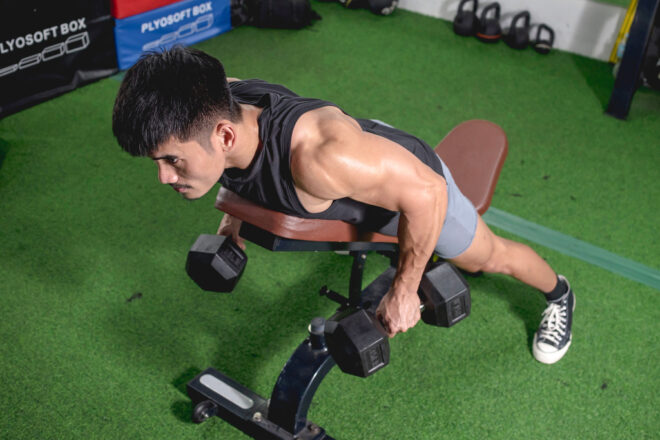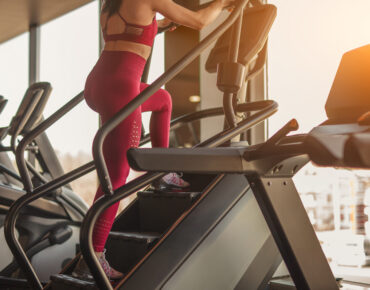Looking for an exercise that can isolate your key back muscles? And work your biceps too? The chest-supported row could be just right for you.
Incline dumbbell rows activate your back muscles without putting too much strain on your lower back. They’re great for beginners as they help you focus on form.
Read on to find out how to do dumbbell rows. We’ll also show you how to get the dumbbell row form right.
In This Article:
What Is Chest-Supported Row?
A chest-supported row is a dumbbell row you do with chest support. You may have also heard this exercise called incline dumbbell row, incline bench row, chest-supported rear delt row, or chest-supported DB row.
The support usually comes in the form of a padded incline bench set at a 30- to 45-degree angle. You can also do the exercise on a T-bar row machine. This machine looks like an incline bench but uses a barbell that you lift through a T-bar.
In the basic version of the exercise, you rest your chest on the inclined bench. Your arms hang on your sides, each holding a dumbbell. During the exercise, you bring these weights toward your chest.
The chest support prevents body motion. The bench support helps you isolate your back muscles by keeping you still. You don’t waste any energy standing or balancing.
The beauty of chest-supported rows is that you can fully focus on form.
How to Do Chest-Supported Rows – Step-by-Step Guide
Positioning is essential to doing chest-supported rows correctly. It also enables you to pay full attention to form. Here’s how to get chest-supported rows right from the first workout.
1. Set your incline bench at a 30- to 45-degree angle. An angle closer to 45 degrees makes the exercise easier. So it’s a good start for beginners.
2. Grab a dumbbell in each hand and straddle the bench. We’ll be talking later in this guide about the optimal weight you should use for a dumbbell chest-supported row.
3. Rest your chest and torso on the angled bench. Your head and neck go over the top of the bench in a straight line with your spine. Plant your feet on the floor and let your arms hang straight down. There should be no tension in your back and shoulders.
4. Row the dumbbells up. Palms facing toward each other, breathe out, and pull your elbows back, driving them toward your chest, to lift the dumbbells toward your ribcage. During this movement, your upper chest should lift slightly off the bench. At the top, pause for a moment and squeeze your shoulder blades. Don’t curve your back.
5. Release the pinch in your shoulder blades. Drop your arms back with a controlled movement and rest your chest back on the bench. This completes a rep.
How Much Weight to Use for Chest-Supported Row
Getting the weight right is important to do the exercise correctly and reap all its benefits. Too much weight, and you’ll risk injury. Not enough weight, and you won’t grow your muscles effectively.
Follow the next steps to figure out your starting weight for the chest-supported dumbbell row.
1. Grab two dumbbells that are lighter than what you think you can lift.
2. Lie down on the bench, ready for the exercise.
3. Try to do 15 rows.
4. If you manage, try with a heavier set that feels more challenging.
5. If you don’t manage, try with a lighter set until you can do 15 rows that are challenging but not exhausting.
In the end, remember that the goal is to grow bigger muscles, not to get injured.
Benefits of Chest-Supported Rows
Few exercises are better at activating your major back muscles than chest-supported rows. Other benefits of doing this exercise include less back strain and better posture.
It also promotes good form, which, for beginners, is harder to achieve with other exercises for the back muscles.
Let’s take a closer look at the benefits of the exercise.
- Grow a bigger and stronger back. Chest-supported rows and their variations isolate your major back muscles without the difficulties of balancing or the back stiffness that comes with doing standing bent-over rows.
- Reduce lower back strain. The exercise requires less lower back stabilization than row exercises without supportive equipment. The chest-supported row helps you train your back while preventing back pain. It’s also great if you’ve had an injury that makes you prone to back pain.
- Improve posture and reduce the risk of herniated disks. Doing chest-supported rows will make you stand up straighter. Stronger back muscles, without back strain, will, in turn, reduce the risk of back injuries.
- Good for beginners. You do chest-supported rows while lying on a bench. This provides stability and allows you to focus on form. The exercise is easier to get right than other exercises for your back.
Good to know: Research indicates that to train your entire back effectively, you need to do a variety of exercises. These include pull-ups, chin-ups, inverted rows, bent-over rows, lat pull-downs, TRX rows, and I-Y-T raises.
Muscles Targeted by Chest-Supported Row
So, what muscles do rows work? Chest-supported rows work most of the muscles of the back. And since they involve arm flexion, they also give your biceps a good workout.
More specifically, chest-supported rows mainly work the rhomboids, infraspinatus, and upper, middle, and lower traps. To a lesser extent, they also work the latissimus dorsi or lats for short.
- Trapezius. Located in the upper back, this kite-shaped muscle helps move and stabilize the shoulder blades. It stretches from the lower back toward your lower neck and spans your upper back horizontally.
- Infraspinatus. This is a thick triangular muscle attached to the shoulder blade and top of the upper arm bone. This muscle rotates the shoulder joint and helps with the extension of the shoulder.
- Rhomboids. This diamond-shaped muscle group is located in your upper back between the shoulder blades. When you push or pull, it pulls the shoulder blades.
- Lats. The latissimus dorsi muscles are the largest in the upper body, stretching from the mid-back to the lower back. They help adduct, extend and rotate the arm. They are the main pulling muscles in the back and help with breathing, too.
- Biceps. Sitting atop your upper arms, the biceps flex the elbow.
Altering your grip can help you work back muscles differently. An overhand grip works your upper back more than an underhand grip. The latter hits mostly your middle and lower traps while also engaging the biceps more.
The width of the grip can also make a difference. A narrow grip means pulling lower. This works your middle and lower traps as well as your lats more. A wide grip, on the other hand, hits your rear deltoid, rhomboids, and trapezoid.
Good to know: A comparison study found that the inverted row activates the upper back, lats, and hip extensor muscles more than standing bent-over rows and standing single-arm cable rows. It also places the least load on the spine, reducing spine stiffness.
Other Types of Chest-Supported Rows
Once you master the basic row, add variation to your workouts with other types of rows. Combining multiple row exercises helps you work all your back muscles, engage your core, and activate other muscle groups.
Chest-supported T-bar row
For this compound exercise, you need a T-bar row machine commonly found in gyms. It primarily targets the lats, scapula, trapezius, and rear deltoid head.
1. Press your sternum against the chest-supported row machine.
2. Plant your feet at shoulder width on the machine’s foot platform or on the floor, depending on the machine.
3. Grasp the T-bar by its handles and hoist it toward your midline while keeping your body braced. Keep your spine and shoulder blades in a neutral position. Avoid flexing your neck.
4. Bracing your core, pull the bar and bring it up until your shoulder blades touch. Strive for a 45-degree upper arm position relative to your trunk during the midpoint of the movement. Don’t let your elbows flare much: your lats, not elbows, should do the work.
5. Straighten your elbows and return the bar to the initial position with a controlled movement to complete a rep. Flare your elbows slightly and feel the stretch at the bottom. Don’t let the weight fall.
6. Allow the resistance to settle, retract your shoulder blades, and repeat the movement for another rep.
7. Do 10–20 reps and up to 4 sets with a 2–3 minute break between them.
Barbell chest-supported row
For this exercise, you’ll need an Olympic bar, weight plates, and a squat rack. Start with a light load.
1. Set the bench near the rack at a 45-degree angle.
2. Place the squat rack hooks at a height that allows you to reach them as you lie on the bench. The bench should be over the center of the barbell.
3. Lie down on the incline bench with your chest pressed against it. Keep your feet on the ground.
4. Hold the bar with a neutral grip and tighten your shoulder blades.
5. Lift the bar toward your chest with a controlled movement.
6. Return the bar to the initial position, maintaining control over the movement.
7. Do 5–15 reps and up to 3 sets with a 2-minute break between them.
Helms row
A lesser-known bench row variation, the helms row can be more convenient to do in some gym setups than other similar exercises. This incline DB row mostly works the lats.
1. Place your chest on the end of an inclined bench set at 45 degrees. For this variation, you’re not straddling or lying on the bench. You remain standing.
2. Bend your knees slightly and keep your back parallel to the floor.
3. Bring the weight up. Pull your elbows back and engage your shoulder blades.
4. Lower the weight with a controlled movement and repeat.
5. Do 10–12 reps and up to 3–4 sets with a 2-minute break in between.
How to Adopt Chest-Supported Row in a Training Plan
Do you want to build muscle endurance? Aim for many reps with a lighter weight. But if you want to grow your back muscles and biceps, do fewer reps with heavier weights.
- For muscle endurance: Do 10–15 reps with lighter weights. Aim for 2–4 sets with a 2–3-minute break in between.
- For muscle strength: Do 10–12 reps with heavy weights. Aim for 3–4 sets with a 2–3-minute break in between.
- For muscle growth: Do 6–10 reps with the heaviest weights you can handle. Aim for 3–4 sets with a 2–3-minute break in between.
Either way, you want to increase the load on your muscles progressively to keep seeing gains.
Do chest rows twice or three times a week or according to your personalized training plan. Combine them with other variations of the exercise for optimal results. If you do other back exercises alongside chest rows, do this exercise less frequently.
Takeaways
Before you head to the gym, here are some things to remember:
- Chest-supported row works your back muscles and biceps without straining your lower back.
- Start with a 45-degree bench incline.
- Up the difficulty by progressively increasing the incline to 30 degrees.
- Use heavier weights with fewer reps to maximize muscle growth.
- Combine the chest-supported DB row exercise with other incline row exercises to work all your back muscles.
In the end, chest-supported rows are some of the best exercises you can do for your back. Try them out!
References:
- Henwood, T.R. and Taaffe, D.R., 2006. Short‐term resistance training and the older adult: the effect of varied programmes for the enhancement of muscle strength and functional performance. Clinical physiology and functional imaging, 26(5), pp.305-313.
- Beaudette, S.M., Unni, R. and Brown, S.H., 2014. Electromyographic assessment of isometric and dynamic activation characteristics of the latissimus dorsi muscle. Journal of Electromyography and Kinesiology, 24(3), pp.430-436.
- Kompf, J.M., Rhodes, R.E. and Lee, S., 2022. Selecting Resistance Training Exercises for Novices: A Delphi Study with Expert Consensus. American Journal of Lifestyle Medicine, p.15598276221115662.
- Calculator, B.M.I., Calculator, B.M.R., Calculator, T.D.E.E., Calculator, B.F., Calculator, W.L. and Calculator, W.G., 12 Best Back Exercises For Building Muscle Mass And Strength.
- DiMarco, N.M., Joy, J.M., Vogel, R.M., Broughton, K.S., Kudla, U., Kerr, N.Y., Davison, J.M. and Wildman, R.E., 2018. Daytime and nighttime casein supplements similarly increase muscle size and strength in response to resistance training earlier in the day: a preliminary investigation. BMC.














